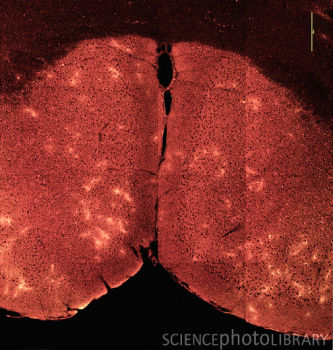据美国物理学家组织网9月14日(北京时间)报道,美国科学家首次发现,老鼠身体内产生的一种分子——腺嘌呤核苷受体能对大分子进入大脑进行控制,当腺嘌呤核苷受体在组成血脑屏障的细胞上被激活时,就会建立起一个进入血脑屏障的通道。相关研究发表在最新出版的《自然•神经科学》杂志上。

科学家们表示,最新研究或将解开“如何安全地打开和关闭血脑屏障”这个困扰科学界长达百年的谜团,科学家们可借此更有效地治疗阿尔茨海默病、多发性硬化症、与中央神经系统有关的癌症等。
血脑屏障是介于血液和脑组织之间的屏障结构,它由构成大脑血管的特定细胞组成,其对血液中的物质进入大脑具有选择性通透的作用,能在阻止细菌的同时让氧气进入大脑,以保障脑内环境的稳定。然而,血脑屏障也将药物阻挡在外,成为科学家治疗脑神经疾病的障碍。
100多年来,大制药公司一直在寻找让药物能突破血脑屏障来治病救人的方法。科学家们试图通过改变药物使其能依附于受体和其他分子上穿越血脑屏障,从而进入大脑中,但是,该修改过程会使药物失效。该研究的领导者、康奈尔大学的免疫学助理教授玛格丽特•拜努表示:“利用腺嘌呤核苷受体似乎是一个更通用的方法,利用这个机制可打开和关闭血脑屏障。”
在实验中,拜努团队成功地将葡萄聚糖和抗体一样大小的大分子运送至大脑中,试图厘清它们能让大分子到达何处以及这种方法是否对分子的大小有要求。他们也成功地让一个β淀粉样肽抗体穿过转基因老鼠的血脑屏障,并观察到它依附于导致老鼠罹患阿尔茨海默病的淀粉状蛋白斑上。在老鼠体内,还有很多已知的对抗剂(专门阻止信号传递的药物或者蛋白)可作腺嘌呤核苷受体。
拜努团队在人体内也发现了这种腺嘌呤核苷受体。他们还发现,获得美国食品药品监督管理局批准的、基于腺嘌呤核苷的药物——心肌灌注造影剂Lexiscan也能轻易打开通过血脑屏障的通道。下一步他们计划探索递送治疗脑癌药物的方法以及更好地理解腺嘌呤核苷受体控制血脑屏障背后的生理机制。
生物探索推荐英文文章阅读:
The researchers found that adenosine, a molecule produced by the body, can modulate the entry of large molecules into the brain. For the first time, the researchers discovered that when adenosine receptors are activated on cells that comprise the blood-brain barrier, a gateway into the blood-brain barrier can be established.
Although the study was done on mice, the researchers have also found adenosine receptors on these same cells in humans. They also discovered that an existing FDA-approved drug called Lexiscan, an adenosine-based drug used in heart imaging in very ill patients, can also briefly open the gateway across the blood-brain barrier.
The blood-brain barrier is composed of the specialized cells that make up the brain's blood vessels. It selectively prevents substances from entering the blood and brain, only allowing such essential molecules as amino acids, oxygen,glucose and water through. The barrier is so restrictive that researchers couldn't find a way to deliver drugs to the brain – until now.
"The biggest hurdle for every neurological disease is that we are unable to treat these diseases because we cannot deliver drugs into the brain," said Margaret Bynoe, associate professor of immunology at Cornell's College of Veterinary Medicine and senior author of a paper appearing Sept. 14 in the Journal of Neuroscience. Aaron Carman, a former postdoctoral associate in Bynoe's lab, is the paper's lead author. The study was funded by the National Institutes of Health.
"Big pharmaceutical companies have been trying for 100 years to find out how to traverse the blood-brain barrier and still keep patients alive," said Bynoe, who with colleagues have patented the findings and have started a company, Adenios Inc., which will be involved in drug testing and preclinical trials.
Researchers have tried to deliver drugs to the brain by modifying them so they would bind to receptors and "piggyback" onto other molecules to get across the barrier, but so far, this modification process leads to lost drug efficacy, Bynoe said.
"Utilizing adenosine receptors seems to be a more generalized gateway across the barrier," she added. "We are capitalizing on that mechanism to open and close the gateway when we want to."
In the paper, the researchers describe successfully transporting such macromolecules as large dextrans and antibodies into the brain. "We wanted to see the extent to which we could get large molecules in and whether there was a restriction on size," Bynoe said.
The researchers also successfully delivered an anti-beta amyloid antibody across the blood-brain barrier and observed it binding to beta-amyloid plaques that cause Alzheimer's in a transgenic mouse model. Similar work has been initiated for treating multiple sclerosis, where researchers hope to tighten the barrier rather than open it, to prevent destructive immune cells from entering and causing disease.
Although there are many known antagonists (drugs or proteins that specifically block signaling) for adenosine receptors in mice, future work will try to identify such drugs for humans.
The researchers also plan to explore delivering brain cancer drugs and better understand the physiology behind how adenosine receptors modulate the blood-brain barrier.







